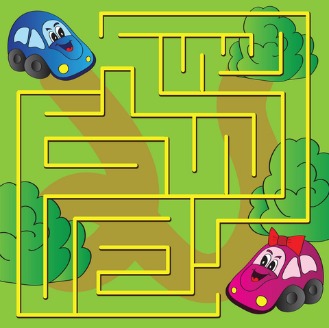What to do with this activity?
Marking a route in a simple maze is fun and great practice for your child. They can gradually learn to control their hand and finger movements, skills that are important in future writing. Encourage your child to follow the correct maze route with their pointing finger first - call it Peter Pointer if you like. Show them that sometimes you reach a dead-end and have to find a new way to go.
Here are some simple online mazes that your child can trace with a finger on your smart phone. Alternatively, with your help, they can make a mark the route using the computer mouse (hold down left click and drag).
Later they can try to mark the route of a maze using a pencil or crayon on paper. You can find easy maze puzzle books in your local newsagent or bookshop. Or you can download and print out mazes like these printable mazes from Kidspot. Choose the easier ones that suit your child. Here's a more difficult Paddington Bear maze to print out (from Words for Life).
Mazes are also great for developing problem-solving skills, concentration and hand-eye co-ordination.
-
Why am I doing this?
There are at least four stages in learning to write. The first is movement - your child learning to control their body and their hands - reaching, feeling and holding things - is part of this first stage.
The second stage is making marks - seeing that if you put this crayon here and move it, it makes a mark.
Drawing is a third stage.
The fourth then is learning how to make letters and later words.
For your child, the more they are aware about how useful writing is, the better. Seeing you writing is great and you pointing out other people writing will help them see how useful it is too.
-
How can I do more?
It’s always good to keep crayons and paper close at hand, so that you can give them to your child anytime to play with.
Write words under your child’s drawing – like their name or what they have drawn – that will help them understand the meaning of words.
Later you could clip 10 or 12 of these drawings together to make a book. This will show your child how books can be made.
Let your child see you writing – notes, lists, letters and emails. If you don't write much yourself, show your child other people writing when you are out and about.
Encourage your child to use ‘pretend’ writing in play - writing their own name, notices or price lists. You could even give them a little notebook when you go to the shops or when they’re playing ‘shop’ with their friends.
Rate this activity
![]()
![]()
![]()
![]()
![]()
Based on 32 reviews
How would you rate it?
1 = Poor, 5 = Great.



